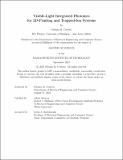Visible-Light Integrated Photonics for 3D-Printing and Trapped-Ion Systems
Author(s)
Corsetti, Sabrina M.
DownloadThesis PDF (16.21Mb)
Advisor
Notaros, Jelena
Terms of use
Metadata
Show full item recordAbstract
Silicon photonics has enabled next-generation optical technologies that have facilitated revolutionary advances for numerous fields spanning science and engineering, including computing, communications, sensing, and quantum engineering. In recent years, the advent of visible-light integrated photonics platforms has opened up the potential for further diverse applications. This thesis builds upon these recent technologies to demonstrate novel applications of visible-light integrated photonics.
First, we combine the fields of silicon photonics and photochemistry to propose the first chip-based 3D printer, consisting of only a single millimeter-scale photonic chip without any moving parts that emits reconfigurable visible-light holograms up into a simple stationary resin well to enable non-mechanical volumetric 3D printing. This work presents a highly-compact, portable, and low-cost solution for the next generation of 3D printers.
Next, we propose integrated-photonics-based system architectures and the design of key integrated-photonics components for both polarization-gradient and electromagnetically-induced-transparency cooling of trapped ions. Further, we experimentally demonstrate a pair of polarization-diverse gratings and design the first integrated polarization rotators and splitters at blue wavelengths, representing a fundamental stepping stone on the path to advanced operations for integrated-photonics-based trapped-ion quantum systems involving multiple polarizations.
Finally, we demonstrate optical trapping and tweezing of microspheres and cancer cells using an integrated optical phased array for the first time, representing a two-orders-of-magnitude increase in the standoff distance of integrated optical tweezers and the first cell experiments using single-beam integrated optical tweezers.
Date issued
2023-09Department
Massachusetts Institute of Technology. Department of Electrical Engineering and Computer SciencePublisher
Massachusetts Institute of Technology